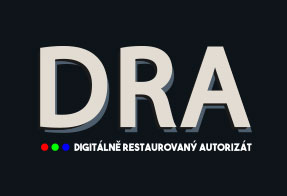Introduction of Research project NAKI

Research project NAKI

Research project NAKI
Digitisation itself is a benefit for image qualities previously not obtainable from the original negative of a film work. Besides those, it is inappropriate to devise safeguards protecting digitised film copies against improvements made by the authors while not stipulating a single safeguard against endless deterioration of the appearance of film works due to commercial interests of “experts” who are not authors of these works. The fact that the appearance of a film work, digitised by these “experts”, cannot be compared with the original appearance of such a film work is unacceptable not only for authors but also for the audience who are thus cheated and their demands are ignored.
Digitally Restored Authorizate (DRA)
is a digital transfer from the Original Camera Negative (OCN) or if not available from the intermediate films (IM)1 approved by the Director of Photography and Representatives of a professional Author Cinematography Association according to the Reference Show Print (RP)1. DRA is physically represented by Master Archive Package (MAP)1 as a long-term digital preservation master and Digital Cinema Distribution Master (DCDM) as digital projection master while both of these satisfy the below criteria.
News:
The Digitally Restored Authorizate (DRA) can be considered the original source of a film work only if it meets the following criteria:
1) the image is digitised in resolution corresponding to the original cinematographic material + in the original frame rate + in the aspect ratio and image size corresponding to the original + with the sufficient range of brightness and colour depth of the image faithful to the original;
2) it is produced with the supervision of officially recognized professional film restorers
3) it is produced with the collaboration of authors of cinematography, sound and direction (if they are available) and representatives of their professional associations;
4) it is approved by an expert group consisting of restorers and authors (officially recognized film restorers, the aforementioned authors of the cinematographic work if they are available and representatives of professional associations of authors) whose members should sign, after mutual consent, an official certification document on the DRA;
5) the differences in visually perceptible quality between RP and DRA must be in reference to image tonality and colour distribution unrecognizable as a key prerequisite for preserving the authenticity of film heritage;
6) it is used as the single source for creating the Intermediate Access Package (IAP) from which, subsequently, all the copies of any distribution formats (digital cinema, television, home video, web etc.) are made, namely without any intervention into the appearance of the work as per the above-defined criteria (except for the changes in the overall size of the image and the different levels of compression depending on the respective distribution format).
In case that those criteria are not fulfilled, the digital master without official certificate has to be considered an infringement of unwaivable moral rights and copyrights of cinematographers as co-authors of film works.
Sample:
.
Closely Watched Trains – during the film’s restoration, the DRA method was being verified
.
All My Compatriots – launch of the NAKI project on methodologies of digitisation of the National Film Fund.
.
The Firemen’s Ball – disputes about the 1:1.66 format. The need for cinematographers to participate in the restoration.
.
Markéta Lazarová – the emergence of the Digitally Restored Authorizate method.
